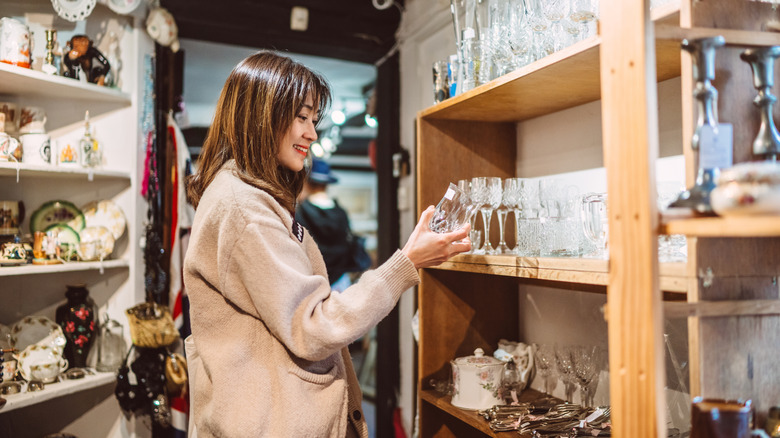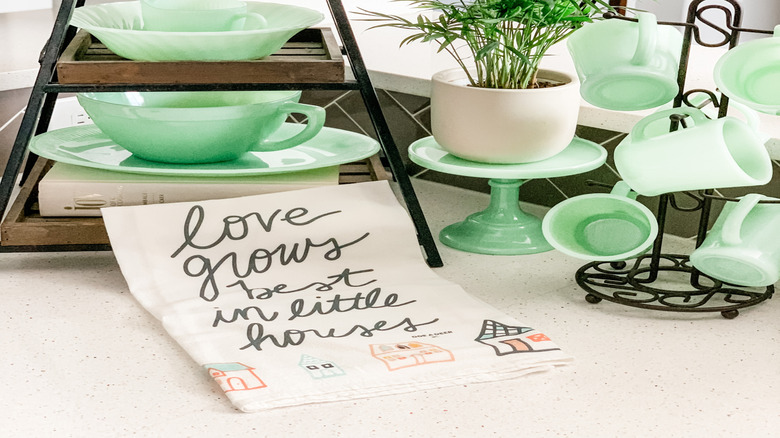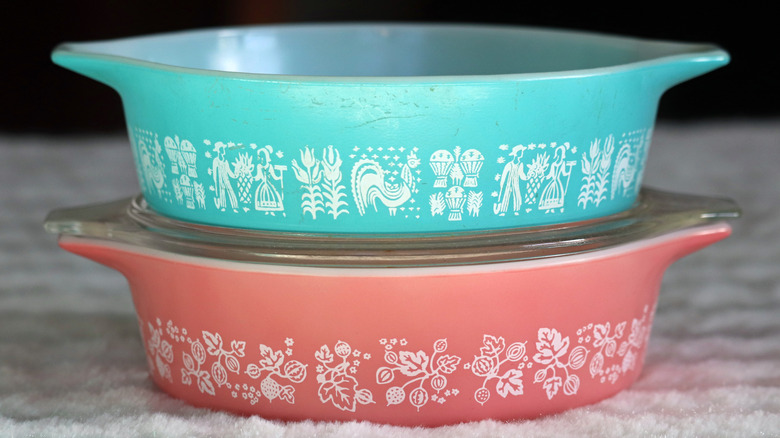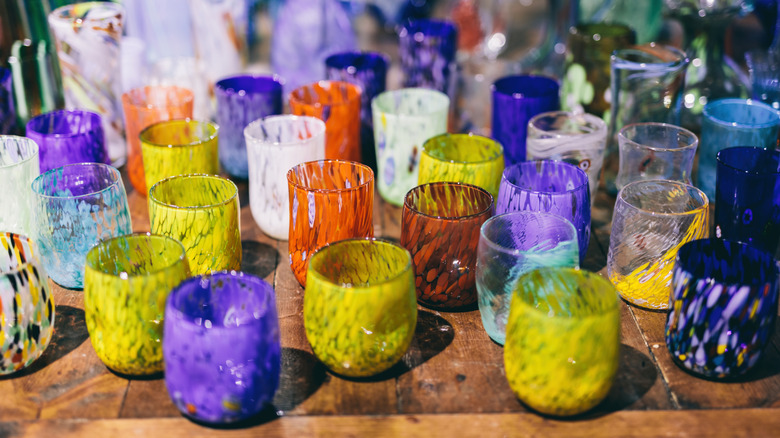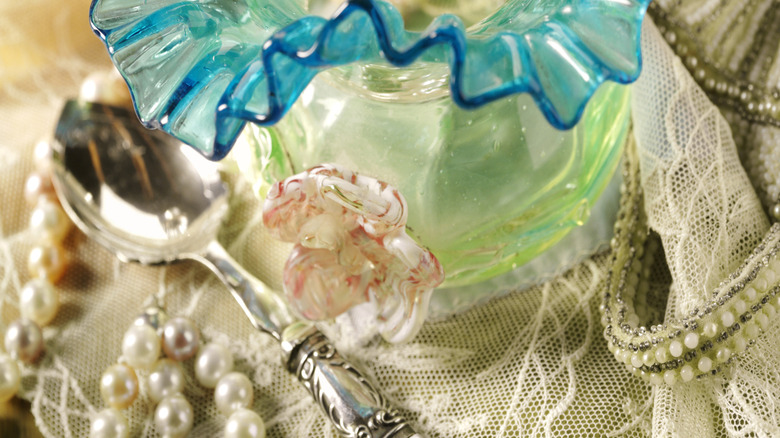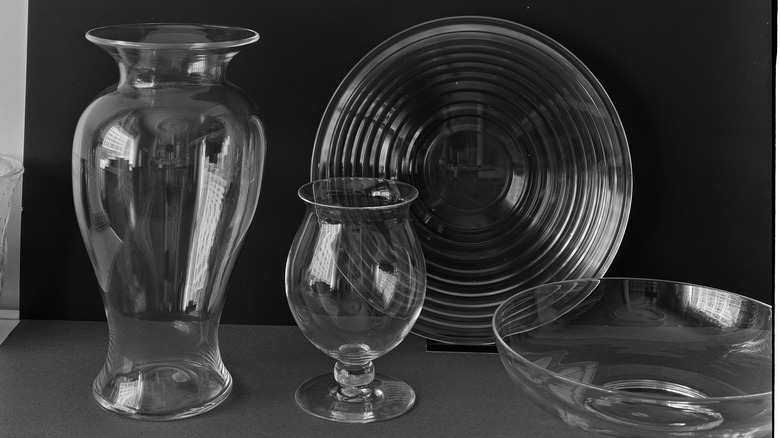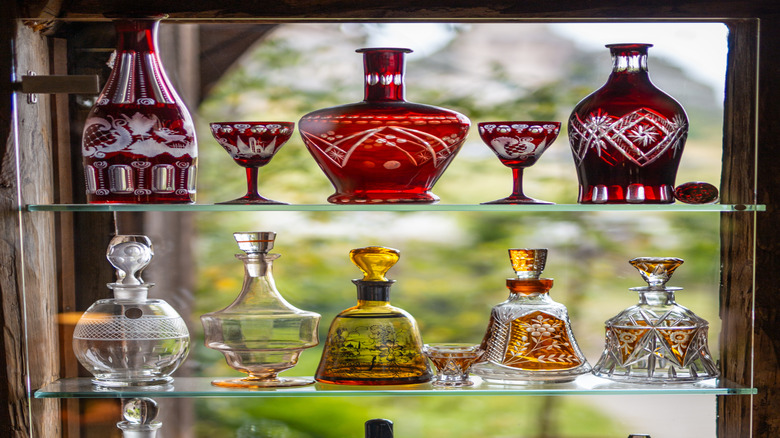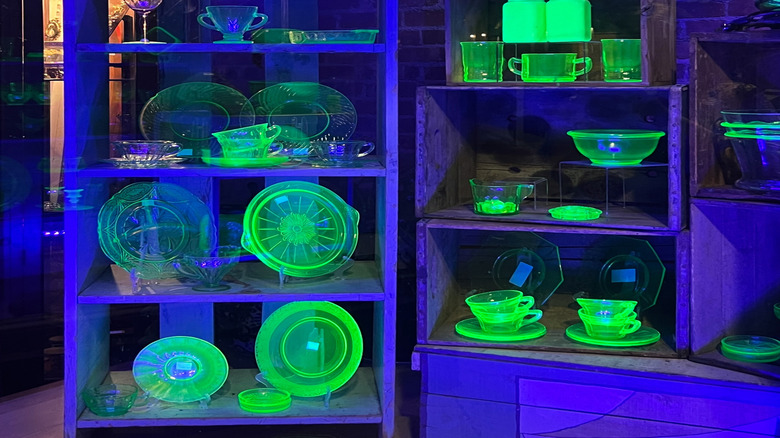Valuable Glass Items You Should Be Looking For At Thrift Stores And Estate Sales
Thrifters love to look for hidden deals in the aisles of their local secondhand store. And while there are always great items to be found in the clothing, shoes, or bag sections, the really hidden treasures are often found in the glass aisles. Those nondescript-looking champagne flutes could be a surprise Tiffany & Co. set that's worth more than your last few thrift store hauls.
Before becoming a House Digest writer, I too spent time wandering the glass and homewares aisles of my local thrift stores, looking for that rare piece that takes a certain eye to notice. My days of collecting and selling rare glass are gone — one's collection, or hoard, can only get so big, you know? But my retirement doesn't mean that the thrift stores and estate sales have dried up. In fact, they're far from it. So, here are a few recommendations for what to keep an eye out for the next time you hit up that church basement thrift store or busy estate sale. We'll go over what makes it so special, how to make sure it's authentic, and a ballpark range for the value you can expect to get should you decide to flip it for profit.
Anything from Fire-king's Jadeite line is always highly collectible
Jadeite refers to the color of the glass that was available in a few collections during the 1930s through 1970s. Originally launched as a type of Depression Glass, jadeite's hybrid milk/green glass coloring made it unique and, consequently, highly sought after by Depression Glass collectors. Three US vintage brands created the charming retro dishware: Anchor Hocking/Fire-King, McKee, and Jeanette, yet the Fire-King brand is the most collectible.
If you find a true piece of Fire-King jadeite, consider yourself lucky, as their value can range anywhere from $5 to $1,000, depending on the condition and pattern. If you happen to stumble on the ultra-rare Fire-King casserole dish in the "Swirl" pattern, you've hit the jackpot as these can for up to $5,000 each. However, don't quit your day job if you stumble on a jadeite piece in the thrift store because you'll need to check the maker's marks. Both Martha Stewart and The Pioneer Woman have launched their own contemporary lines of jadeite glassware and decor, which are worth considerably less, though still lovely. Anchor Hocking also reissued a few of their jadeite lines in 2000 and was kind enough to stamp "2000" on the bottoms of the pieces to differentiate them from the originals.
Keep your eyes peeled for rare Pyrex patterns
Vintage Pyrex is often the first entry point for glass collectors, and it's easy to see why. The patterns are produced with care, the colors are awesome, and vintage Pyrex is known to be incredibly durable. Just keep in mind that there's a difference between Pyrex and PYREX. Some patterns are more sought-after than others, and their relatively commonplace supply means condition really matters when it comes to value. A commonly found pattern or piece that has bad wear can be worth $0 to collectors, while a pristine, rare, promotional piece can fetch over $5,000.
The Corning Museum of Glass' website and Pyrex Love have a fantastic pattern library to reference, including promotional and hard-to-find pieces. In my experience, the most popular patterns are Primary Colors (1945-1949), Butterprint (1957-1968), Friendship (1971-1974), Snowflake (1956-1967), Snowflake Blue (1972-1975), and Gooseberry (1957-1968). However, the super-rare patterns that could make your palms sweat should you run into them are: Hex Signs (1958), Midnight Bloom (1970-1971), Starburst (1960), Zodiac (1961), and the ultra-mega-rare Golden Branch (1959) and Floral (1965), with the latter two only being produced promotionally, making them even more rare.
Tiffany & Co. glass items are easier to find in a thrift store than you think
When you think of Tiffany glass, you're probably thinking of the colorful Tiffany lamps which are officially back in style. And while it would be amazing to stumble on a genuine antique Tiffany Studios piece, contemporary Tiffany & Co. branded items are much easier to find secondhand. Depending on the type and condition, Tiffany & Co. glassware or decor can range from $3 to $2,600 on the resale market.
Searching for Tiffany glassware can take some time as their pieces aren't particularly unique-looking. This is particularly true when they're crammed on a shelf with dozens of other glassware. So, look for heavy-feeling, high-quality pieces and check the underside or base of the piece to find the maker's mark, which is typically just a laser-etched "Tiffany & Co."
Anchor Hocking advertising coffee mugs are super popular and rare
Anchor Hocking didn't just make jadeite; they've been in the glass business since 1905 and have a plethora of collectible glassware that vintage hunters love. In 1940, it began its Fire-King brand, which was known for being durable and able to withstand thermal shock, meaning it could go from the fridge to the oven right away, and vice versa. It became so popular that companies began to use Fire-King branded mugs as promotional items, with their color logos painted front and center on the face. While Fire-King branded coffee mugs are already collectible, the advertising ones have the highest prices on eBay, ranging from $5 to over $200.
The mugs come in a wide variety of shapes with some meant for stacking while others with the iconic D-shaped handle, so you'll want to look more for the imagery than the shape. Most advertising mugs were plain white, milk glass with a full-color logo painted on at least one side of the mug's face. McDonalds, White Castle, Coca-Cola, and many regional brands all used the promotional mugs, so it's hard to narrow down specific companies to look for. To make sure it's authentic vintage Fire-King, first check the underside for the maker's mark; if there's a country listed that's not the United States, it's a reproduction. Next, check the design. Authentic promotional mugs had their designs painted on and then fired while new reproductions will often be vinyl stickers or appliqués.
Carnival glass looks amazing and can be valuable
While Tiffany's released their gorgeous, and high-priced, stained glass pieces, glass manufacturers were looking for ways to compete. In 1905, the first "poor man's Tiffany" glass pieces were launched. Known as "Carnival Glass" these jewel-toned glassware or decor pieces had an iridescent sheen thanks to metallic salts fired onto the finish. Their name stems from their origin, as they were often given as prizes at carnival games, and were manufactured by many brands, including Northwood, Dugan, Fenton, Jeanette, L.E. Smith, and others. The value of each piece depends on its pattern and the finishes' condition, but you can expect to get anywhere from around $6 to over $2,500 on eBay. However, in 2018, two Carnival Glass vases went for $155,000 and $140,000 at auction, respectively, so don't skip the vase section of your thrift store.
In my opinion, every colorful piece is worth collecting due to its beauty, but here are some tips for thrifting authentic carnival glass. First, look at the bottom to determine the glass' base color. Red, aqua, peach, and milk glass are the most valuable, while marigold, amethyst, amber, green, and bright blue are more common. The super-ultra, valuable color is Northwood's Black Amethyst, which is so dense with pigment that it looks totally black and often requires an experienced eye to determine authenticity. Next, look at the design. Popular patterns are Northwood's Poppy Show (1913), Good Luck (1909-1917), Grape and Cable (1910-1918), Fenton's Holly (1910-1929), and Dragon and Lotus (1913-1927). Rare patterns that are worth considerably more include Fenton's Strawberry Scroll (1912) and Dugan's Farmyard (1909-1913).
Murano glass looks incredible and can be worth a pretty penny
In 1291 the island of Murano in Venice, Italy, began manufacturing the glass that would become world-renowned. Murano glass is hand-blown, often containing precious metals to create its bold colors, and became so sought-after that it was regularly gifted to royalty and aristocracy. While it's unlikely you'll spot a piece from the late 13th century at your local Goodwill, there's a pretty good chance you'll find a valuable contemporary piece. Depending on the condition and type, Murano glass can be worth anywhere from $1 to over $8,000.
Spotting this best-kept secret of many thrifters, valuable Murano glass means looking at the details, so don't worry if your first couple of scores end up being reproductions. Typically, there are three distinguishing characteristics that distinguish genuine from fake. First, look for imperfections. Due to its hand-blown nature, no two pieces are identical. So, look for air bubbles and pontil marks, the spot on the bottom where the piece was cut from the glass rod. Next, look for a signature and certificate of origin sticker; while the latter might be easier to dupe, all Murano glass masters are registered and easily verified online. Finally, look at the coloring and see if you can notice any metals. True Murano glass has strikingly bold colors, and many use precious metals like 24k gold, sterling silver, cobalt, or copper to create their colors.
Keep an eye out for genuine Art Glass
During the turn of the 20th century, glassmakers began to lean into their craftsmanship and produced unique items that are known as Art Glass. Tiffany's, Steuben, Lalique, Baccarat, and other glassmakers became proficient Art Glass creators, churning out unique pieces that were more form than function. Consequently, these are highly collectible, with pieces selling recently on eBay from $5 to $11,000.
Art Glass is often mistaken for Depression Glass but is typically more valuable and, unfortunately, harder to identify. First, look at the piece type. Art glassmakers typically created more decor and less tableware, so things like perfume bottles, chandeliers, and decorative objet d'art are more likely Art Glass. Next, look for a maker's mark. Sadly, not many pieces are signed, so finding a true glassmaker's signature can be helpful in determining authenticity. Good books that have cataloged authenticated pieces are The Art Glass of Louis Comfort Tiffany, Art Glass: How to Compare & Value and Art Glass: Identification & Price Guide, though prices fluctuate so keep that in mind.
Steuben glass might look plain, but it's very valuable
In 1903, glassmaker Frederick Carder launched his studio, Steuben. It was named as a homage to Steuben County, NY, the home of Corning Glass, makers of the original CorningWare, Pyrex, and as of 1918, Steuben. The value of Steuben glass comes from its custom formulation that creates prismatic crystals that can capture the light while remaining shockingly crystal clear. Occasionally, though, colored Steuben pieces were created, with a rose quartz vase selling at Sotheby's for $7,200. While it's a rare score at a thrift store, if you happen to be lucky enough to stumble on a Steuben piece, you're looking at a value between $18 and $4,500.
Identifying Steuben glass is tricky since only a few pieces are signed and there are multiple maker's mark stamps Carder used. The Carder Steuben Glass Association has a library of authenticated signatures that can help identify true pieces, should you hit the thrifting jackpot. For the rest of us, your best bet is to learn about authenticated pieces to train your eye. One great book for this is Steuben Glass: An American Tradition in Crystal, but making a pilgrimage to the Corning Museum of Glass can be even more helpful.
Depression glass is always popular, but some colors are more valuable than others
In 1929, the Great Depression began, disrupting economies around the world. While many trades suffered, glass manufacturers decided they would evolve rather than die off. So, Depression Glass was created: a machine-made glass that could be easily mass-produced and still come in a range of colors, patterns, and pieces. Some were available to purchase off the shelf, but most of it was sold to companies that needed promotional items to get people in the doors. Movie houses, gas stations, etc. would give away a piece at a time, encouraging people to return for the full set. Today, the value of the piece depends on its color, condition, and pattern; pink or green glass are usually easy to find and, consequently, less valuable, ranging from $1 to $600. Meanwhile, rarer colors like amethyst, ultramarine, black, or delphite can sell from anywhere from $2 to over $1,300.
If you want to keep your glass collecting simple, shoot for Depression Glass since it's easily identifiable and relatively easy to spot. Most have maker's marks on the bottom, which is helpful as, like jadeite, contemporary reproductions are springing up. The true Depression Glass brands are Jeanette, McKee, Anchor Hocking, Macbeth-Evans, Federal, Indiana, Fenton, Lancaster, U.S. Glass, and Hazel-Atlas.
Also, look for a seam along the pattern. Since Depression Glass had to be mass produced by machines, there wasn't much finishing done, so mold seams along the glass are common. There are hundreds of patterns and dozens of colors that are all true and authenticated but can still be difficult to discern, particularly since some brands have created their own reproductions. I recommend picking up Mauzy's Depression Glass: A Photographic Reference with Prices and Warman's Depression Glass Handbook: Identification, Values, Pattern Guide to help you figure out which pieces are real.
Elegant glass looks like Depression Glass but has a higher value
Made alongside Depression Glass in the early 20th century, Elegant Glass is a little harder to spot. It's typically characterized by its higher quality than its Depression cousins and features intricately cut patterns and designs. Some Elegant Glass is clear and harder to identify, but others like the ruby glass shown above, are pieces that once you see them, will automatically let you know what you're dealing with. Prices vary depending on the color, condition, and piece, but typically range between $8 and $600.
Identifying Elegant Glass is easy once you know what you're looking for. First, look at the design on the piece; Elegant Glass has its pattern etched into the glass and not painted or applied later. Ruby Elegant Glass has its coloring incorporated originally into the molten glass and cannot be rubbed off, while cheaper "ruby flash" pieces have more of a red rim that fades over time to a pinkish hue. Opalescent elegant glass uses a re-heating process to create its look while reproductions typically use a sprayed-on finish.
Next, check the maker's mark. Debbie and Randy Coe, antique glass experts who have authored several books on the subject believe that Cambridge, Central, Consolidated, Duncan & Miller, Fenton, Fostoria, Heisey, Imperial, Morgantown, New Martinsville, Paden City, Phoenix, Tiffin, Viking, and Westmoreland are the only brands to have created true Elegant Glass.
Uranium glass finds can be highly collectible
Uranium glass is often lumped together with Depression Glass, though it's older and arguably more interesting. In the 1830s, Bohemian glassmaker Josef Reidel created the first uranium glass in green and yellow colors. The green was called straight up Uranium glass while the yellow is also known as Vaseline or Canary glass. It rose in popularity until the 1880's when it experienced its true peak thanks to Whitefriars Glass Company which brought it to the mass market. However, as the availability of uranium declined, so too did uranium glass pieces, until in 1958 its production ceased completely thanks to the US' need for uranium for the Manhattan Project. Today, true uranium glass pieces fetch anywhere from $1 to $2,500.
Identifying actual uranium glass requires a black light. However, they're easy to get and some even come on keychains, like this Black Light UV Light by Waklyte, making it easy to verify glass on spontaneous thrifting sprees. First, look for glass pieces that are either green or yellow, then try to get them into a darker area and shine the blacklight over them. If they glow, they're likely uranium.
Signed Lalique glass is gorgeous and very collectible
René Lalique launched his glass company in 1888 and it's still going strong to this day. He was a contemporary of Carder's, the glassmaker behind Steuben, but his techniques for applying enamel and frosting finishes helped distinguish his pieces from would-be reproductions or the Elegant Glass makers who were also popular at the time. If you find a signed piece, you're the luckiest thrifter around. In 2023, a 1921 Lalique vase sold at auction for an astonishing $55,000! For those without auction connections, though, Lalique pieces can net anywhere from $5 to over $8,000 on eBay.
The most valuable pieces are the ones signed "R. Lalique" and made before 1945, the year René died. Of course, pieces that are so valuable often invite counterfeiters, so here are a few ways to tell if your piece is authentic. First, look at the signature mark; R. Lalique means it was done pre-1945, "Lalique" without the R. means it was created by René's son, Marc, between 1945 – 1978, and pieces post-1978 will have an R inside a circle next to Lalique. The authentic signatures are small and placed either within the design or on the base while counterfeits will usually make the mark larger, to signify its so-called authenticity.
Next check where it claims to be from; René would mark it only as "France," while counterfeiters put "Made in France" or "Made in Paris." Also, check the weight. Lalique used 12% lead oxide in his crystal, while his son Marc doubled it to 24% post-1945, so genuine pieces are heavy. You can also check the lead content with a black light. Pre-1945 pieces will glow yellow while post-1945 pieces glow blue, yet counterfeits won't typically use lead at all so they won't glow.
